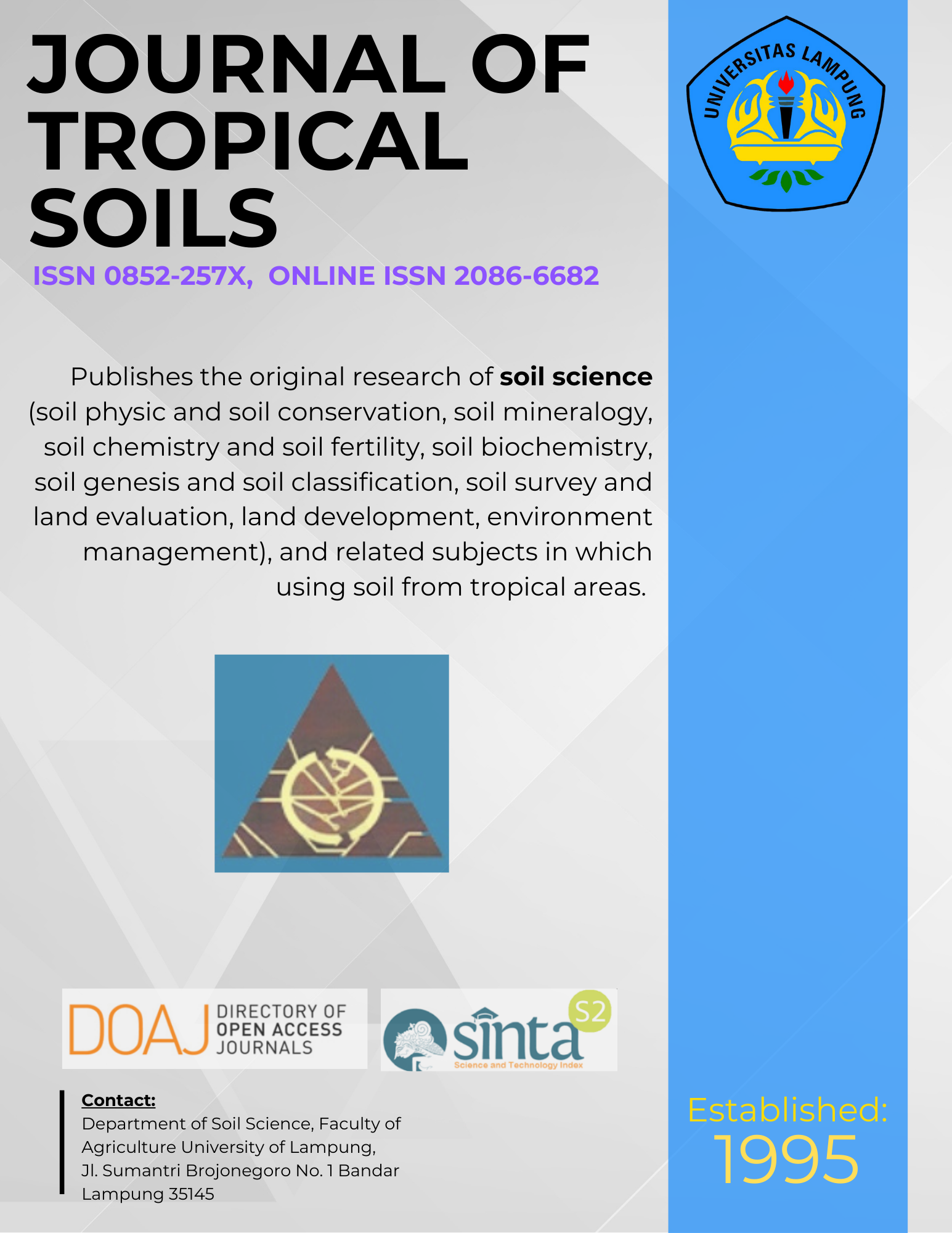Artikel (15)
Global potato production reached approximately 383 million metric tons in 2025, with Indonesia contributing around 1.22 million metric tons (0.32% of global output). However, the sustainability of Indonesia’s potato production is increasingly threatened by soil quality degradation in key grow...
JOURNAL OF TROPICAL SOILS; Vol. 30 No. 3: September 2025 (in Progress) | 2025
The Berbak Delta in Jambi Province, Indonesia, underwent large-scale peatland reclamation in the 1970s to develop rice fields through a transmigration program. Initially, rice production averaged 3–4 tons/ha but declined to less than 1 ton/ha due to the conversion of peat soils into acid sulf...
JOURNAL OF TROPICAL SOILS; Vol. 30 No. 3: September 2025 (in Progress) | 2025
AbstractThis study examines the effects of diverse land use and land cover (LULC) types on soil physico-chemical properties and carbon sequestration potential in the northern Madhupur Tract, Bangladesh. Soil samples were collected from seven LULC types – sal forest, social forest, orchard, ba...
JOURNAL OF TROPICAL SOILS; Vol. 30 No. 3: September 2025 (in Progress) | 2025
Oil palm plantations are a leading sub-sector in Indonesia's agricultural sector which is experiencing rapid growth. Ketapang Regency, as the area with the largest oil palm plantation area in West Kalimantan, has great potential for further development. This study aims to analyze the suitability of ...
JOURNAL OF TROPICAL SOILS; Vol. 30 No. 3: September 2025 (in Progress); 1 | 2025
This research was conducted to determine the effect of planting media on the growth of Moringa stem cuttings and determine the best planting media for growing Moringa stem cuttings. The research was carried out in July-October 2023. Located on the Wasaka III Student Dormitory grounds, Lambung Mangku...
JOURNAL OF TROPICAL SOILS; Vol. 30 No. 3: September 2025 (in Progress) | 2025
The practice of intensive rice field cultivation and the excessive application of chemical fertilizer often lead to issues such as a gradual decline in soil quality and fertility, as well as enviromental pollution. By employing Tetadi as ameliorant technology and adopting SRI cultivation techniques,...
JOURNAL OF TROPICAL SOILS; Vol. 30 No. 3: September 2025 (in Progress) | 2025
Uncontrolled land conversion causes reduced land area for plant cultivation. The alternative used for rice cultivation is the marginal land such as sandy soil, however, several constraints led to very low productivity, so it needs proper management such as the addition of organic matter. The purpose...
JOURNAL OF TROPICAL SOILS; Vol. 30 No. 3: September 2025 (in Progress) | 2025
Limited agricultural land in Indonesia makes peatland an alternative land for agricultural intensification. Peat soil has a low fertility, so applying cellulolytic bacteria and palm oil shoot ash is recommended. This study aimed to determine the effect of cellulolytic bacteria consortium and oil pal...
JOURNAL OF TROPICAL SOILS; Vol. 30 No. 2: May 2025; 97-102 | 2025
This study seeks to evaluate the effectiveness of coconut shell biochar (CB)Â and/or Leucaena compost (LC) as ameliorants in improving soil chemical and physical properties, as well as enhancing tomato yields. The goal is to identify the most effective combination of ameliorant formulations that ...
JOURNAL OF TROPICAL SOILS; Vol. 30 No. 2: May 2025; 85-95 | 2025
Soil degradation is an important problem affecting crop production, especially in cocoa agroforestry systems, where soil health is crucial for optimal results. However, the effect of land management on changes in soil organic matter (SOM) content is often not visible through measurements of total so...
JOURNAL OF TROPICAL SOILS; Vol. 30 No. 2: May 2025; 103-112 | 2025


